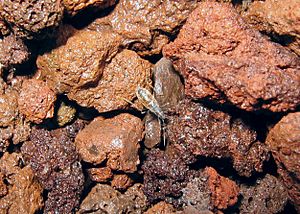Nysius wekiuicola facts for kids
Quick facts for kids Nysius wekiuicola |
|
|---|---|
 |
|
| Scientific classification | |
| Kingdom: | |
| Phylum: | |
| Class: | |
| Order: | |
| Family: |
Lygaeidae
|
| Genus: |
Nysius
|
| Species: |
N. wekiuicola
|
| Binomial name | |
| Nysius wekiuicola Ashlock & Gagné, 1983
|
|
The Wēkiu bug (scientific name: Nysius wekiuicola) is a tiny insect found only near the top of Mauna Kea in Hawaiʻi. It's a special type of seed bug that has learned to live in a very cold and windy place. It's closely related to another bug, Nysius aa, which lives on the nearby Mauna Loa volcano.
Contents
What is the Wēkiu Bug?
The Wēkiu bug is a small insect that cannot fly. It lives high up on Mauna Kea, a volcano in Hawaii. This area is over 12,000 feet (3,658 meters) above sea level. The bug is named after Puʻu Wēkiu, which means "topmost hill" in the Hawaiian language. This is the highest peak of Mauna Kea.
How Does the Wēkiu Bug Survive?
The top of Mauna Kea might look empty and cold. It has cinder cones and lava rock. But many living things have learned to live there. These include lichens, algae, mosses, insects, spiders, and other small arthropods.
There are at least twelve kinds of endemic (found only there) arthropods living on Mauna Kea. These creatures mostly depend on insects that are blown up the mountain by the wind. These wind-blown insects often die when they reach the cold summit.
A Unique Diet
Most other seed bugs eat seeds. But the Wēkiu bug has changed its diet. It eats the insects that are blown to the top of the mountain and die. This food source is bigger than it sounds. Sometimes, snow patches at the summit are covered with hundreds of dead insects.
When the snow melts, Wēkiu bugs can be seen at the edges. They feed on the insects that fall out of the melting snow. These bugs also have a special "antifreeze protein" in their blood. This helps them survive in very cold temperatures.
Protecting the Wēkiu Bug
For a while, people were worried about the Wēkiu bug. The summit of Mauna Kea has many telescopes. Building these telescopes and the tourism traffic has changed the area. This includes compacting the loose cinder soil.
However, the bugs also live in other areas away from the main activity.
Is the Wēkiu Bug Endangered?
Scientists from the University of Hawaii have been studying the Wēkiu bug. Their surveys show that the bug's population is stable. The number of bugs changes each year based on how much rain or snow falls on the summit.
Because of this ongoing study, a request to list the Wēkiu bug as an endangered species was turned down in 2011. Scientists found that the bug's population is stable. They also learned that the bug lives in more places than they first thought. Current threats are small and watched carefully. So, the Wēkiu bug is not considered endangered.
Related Species
The name "Wēkiu bug" is also used for a bug called Nysius aa. This bug is closely related to N. wekiuicola. It lives in a similar way on Mauna Loa, another volcano.
Scientists know even less about Nysius aa than N. wekiuicola. But it seems to be in less danger. The top of Mauna Loa is not being developed like Mauna Kea. Even though many hikers visit, the area is mostly rocky lava. This makes it less affected by human activity.

